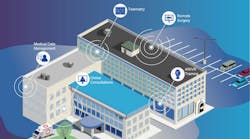In this week’s Voices of the Industry, Jake Ring, CEO of dcBLOX, explains why hyper-convergence in the data center is top of mind for many of today’s IT leaders and explores the new data centers emerging that support hyper-converged infrastructure.
If there is one technology innovation capturing the attention of IT leaders and CFOs alike, it’s hyper-convergence in the data center. The evolution from hardware-defined silos supporting specific applications to converged architectures with dynamic configuration through software defined networking (SDN) has dramatically increased IT flexibility. The enhanced agility empowers organizations to meet customer requirements more efficiently, with undeniable business benefits.
Jake Ring, CEO, dcBLOX
So what’s the catch? While hyper-converged infrastructure and systems offer centralized management, increased scalability and the opportunity to share resources between applications, the equipment that makes this possible can be power hungry. IT leaders may discover that what once appeared to be more than adequate data center capacity is quickly consumed by half-empty rack cabinets running near maximum power loads.
Naturally, this presents a big problem in the traditional data center model that tops out at 7-10kW for a cabinet. Building out space is costly and time consuming, and a traditional colocation facility is not designed to handle elevated loads unless they are spread out over more cage space. Either way, you’re looking at more time and an increasing total cost of ownership (TCO) to implement this dynamic technology for your business-critical applications.
Fortunately, a new breed of data centers is emerging that fully support hyper-converged infrastructures— in fact, they were built for it.
Fortunately, a new breed of data centers is emerging that fully support hyper-converged infrastructures—in fact, they were built for it. These next generation software-defined data centers (SDDC) feature a modular enclosure design, such as those used at Hyperscale IT companies, that isolates mechanical and electrical systems within a self-contained pod, eliminating the need for raised floors and inefficient cooling methods resulting in lower overall Power Usage Effectiveness (PUE). Instead of the traditional 7-10 kW capacity, these data centers can provide up to 30kW per rack cabinet at a PUE of 1.2. That’s more than enough to power a full rack of Nutanix, VxRail, or HP Apollo and eliminate stranded capacity and wasted data center real estate.
Here’s a look at what this mean in terms of some of the promised benefits of hyper-converged:
Scalability
For a rapidly growing organization that needs resources fast, hyper-converged infrastructure is capable of delivering a huge amount of resources that are still closely managed. Network, storage, compute, and virtualization can be implemented on day one and more modules of storage and compute can be quickly bolted on as demand grows.
Users today should expect their data center infrastructure to scale along with the technology. Colocation providers need to be flexible enough to support hyper-converged infrastructure, rather than imposing limits (space and power) on it. A truly power-efficient modular design allows IT teams to quickly expand into a new colocation facility and fill up that 42U or 50U cabinet from top to bottom before having to take on additional space.
Agility
The modular design and improved power densities afford CIOs (and their CFOs) the agility to scale as business demands and realize the promise of hyper-convergence. In addition to adding new physical capacity in days rather than weeks, the software-defined data center (SDDC) approach lets managers deploy applications on demand via managed containers, establishing a business advantage over less agile competitors. Some systems, such as Nutanix, can support mixed workloads, hosting traditional VMs alongside containers for an enhanced level of workload agility.
[clickToTweet tweet=”The software-defined data center approach lets managers deploy applications on demand via managed containers. ” quote=”The software-defined data center approach lets managers deploy applications on demand via managed containers. “]
Reduced TCO
Data centers are notoriously expensive, absorbing large chunks of a growing company’s CAPEX and OPEX budget. However, employing a hyper-converged approach supported within a power-efficient modular colocation partner makes it possible to maximize resource utilization and keep your footprint low. Hyper-converged infrastructures are driving the ultimate commodification of storage and compute, as regardless of brand, storage is storage. Make sure your colocation provider is designed to support the limits of your hyper-converged ssystem to help reduce your TCO. Your CFO will thank you.
Data Security and Disaster Recovery
Distributing backups to different locations via a hyper-converged system enhances the ability to recover quickly in the event of an outage. Multiple locations also enhance resiliency should a widespread crisis like a hurricane, earthquake or mass terrorist attack occur. However, backup data is only as good as your ability to access it when needed, and your provider’s ability to support the bandwidth you need so you don’t wait hours for recovery. Next-gen data centers link their locations through a dedicated optical network, providing bandwidths of 100Gb to not only support greater efficiency in day-to-day operations, they ensure speedy recovery as well.
In the end, your data center is only as good as the “ping, power and pipe” behind it. Unexpected, power-based limitations on rack capacity result in data center sprawl and stranded resources. When planning for advanced deployments, data center managers should consider more than just their choices of hardware and software vendors. They also need to assess capacity constraints driven by power and cooling design, and consider data center evolution strategies that maximize the utilization for hyper-converged infrastructure, which Gartner predicts will achieve mainstream use within the next four years.
Jake Ring is CEO of dcBLOX, an Atlanta-based data center provider utilizing a Next-Gen enclosure technology that allows for more flexible, efficient, and cost-effective infrastructure. The company provides virtual and standard colocation, and network connectivity services between its multiple facilities through its high bandwidth private optical network.





